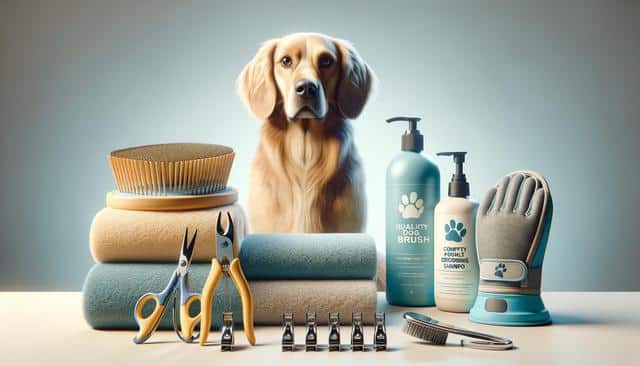Learn More About Essential Dog Grooming Products
Keep your pet happy and healthy with the right grooming essentials. From brushes and nail clippers to shampoos and dental care, this guide helps you choose top-rated products for every breed and coat type. Make grooming a safe, stress-free experience at home with the right tools on hand.

Why Grooming Is More Than Just Aesthetic
Dog grooming goes beyond keeping your furry friend looking tidy. Regular grooming contributes to a dog’s overall health, comfort, and well-being. It allows pet owners to spot early signs of skin issues, parasites, or other health concerns. Grooming also strengthens the bond between owner and pet, especially when done gently and consistently.
Grooming includes activities such as brushing, bathing, nail trimming, ear cleaning, and dental care. Each of these tasks helps maintain hygiene and can prevent health complications. For instance, matted fur can lead to skin infections, while overgrown nails can cause pain or affect movement. By investing in the right grooming tools, you can make these routines easier and more effective.
Some common health benefits of regular grooming include:
- Improved skin and coat health
- Reduced risk of infections and parasites
- Better comfort and mobility through proper nail care
- Early detection of lumps, bumps, or skin conditions
Understanding the importance of grooming helps prioritize it as part of a dog’s regular care routine.
Choosing the Right Brushes and Combs
The type of brush or comb you need depends on your dog’s coat type. Dogs with long or thick fur require different tools than short-haired breeds. Using the appropriate brush not only makes grooming more efficient but also more comfortable for the dog.
There are several types of brushes designed for specific coat types:
- Slicker brushes – Ideal for removing tangles and mats in long-haired breeds
- Bristle brushes – Suitable for short-haired dogs to remove loose hair and dirt
- Pin brushes – Great for medium to long coats, providing gentle detangling
- Deshedding tools – Designed to reduce shedding in breeds with undercoats
Combs can be useful for precision work, especially in areas around the face or paws. Regular brushing also distributes natural oils through the coat, promoting shine and softness. Investing in a well-designed, ergonomic brush can make the process more pleasant for both pet and owner.
Bathing Products and Skin Care
Bathing is another essential part of grooming, but not all shampoos are created equal. Choosing the right bathing product depends on your dog’s skin type, coat condition, and any specific needs such as allergies or sensitivities. Human shampoos should be avoided, as they can disrupt the pH balance of a dog’s skin.
Look for dog-specific shampoos that are free from harsh chemicals and fragrances. Some common types include:
- Oatmeal shampoos – Soothing for dry or itchy skin
- Medicated shampoos – Address specific skin conditions as recommended by a vet
- Hypoallergenic shampoos – Suitable for dogs with allergies or sensitivities
- Conditioning shampoos – Help maintain softness and moisture in the coat
Regular bathing helps remove dirt, allergens, and loose fur, keeping your dog fresh and clean. However, overbathing can lead to dry skin, so it’s important to follow guidelines based on breed and lifestyle. After a bath, always dry your dog thoroughly to prevent chills or skin irritation.
Nail Trimming and Paw Care
Nail trimming is often one of the most overlooked grooming tasks, yet it’s crucial for a dog’s mobility and comfort. Overgrown nails can lead to pain, posture problems, and even joint issues. Using a high-quality nail clipper or grinder designed for dogs can make the process safer and less stressful.
There are two primary types of nail grooming tools:
- Guillotine-style clippers – Easy to use and suitable for small to medium dogs
- Scissor-style clippers – Better for larger breeds with thicker nails
- Electric nail grinders – Ideal for smooth, gradual trimming and reducing sharp edges
It’s recommended to trim your dog’s nails every 3–4 weeks, depending on how quickly they grow and how much natural wear occurs through activity. Paw care also includes checking for debris, cuts, or signs of infection. Moisturizing paw balms can help protect the pads from cracking, especially during winter or hot pavement exposure.
Dental Care and Final Touches
Oral hygiene is a critical yet often neglected part of dog grooming. Dental issues can lead to pain, tooth loss, and systemic health problems. Incorporating dental care into your grooming routine can significantly benefit your dog’s long-term health.
Effective dental care products include:
- Dog toothbrushes and toothpaste – Specially formulated to be safe and palatable
- Dental chews – Help reduce plaque buildup through chewing action
- Water additives – Support oral health when added to drinking water
- Finger brushes – Allow for more control during brushing, especially for small breeds
In addition to dental care, final grooming touches such as ear cleaning and coat trimming can enhance your dog’s comfort and appearance. Always use products designed for dogs, as their anatomy and sensitivities differ from humans. If unsure, consult with a professional groomer or veterinarian for guidance on safe usage and frequency.
Conclusion: Making Grooming a Positive Routine
Dog grooming is a key component of responsible pet care. With the right tools and routine, grooming can be a rewarding experience that supports your dog’s health and happiness. Whether you’re managing a long-haired breed or a short-coated companion, choosing the right products makes all the difference. Brushes, shampoos, nail clippers, and dental care items all play essential roles in maintaining your pet’s well-being. By investing time and care in grooming, you’re not just keeping your dog clean—you’re contributing to their quality of life.